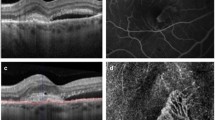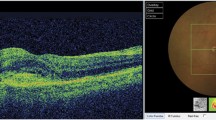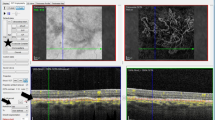Abstract
Purpose
To evaluate the diagnostic accuracy of OCT angiography (OCT-A) detecting or predicting choroidal neovascularization (CNV), by ophthalmologists of disparate degrees of skills in retinal diseases, using spectral domain optical coherence tomography (SD-OCT) and fluorescein angiography (FA) as a standard reference.
Methods
Retrospective observational case series. Patient presenting maculopathy and complete imaging were included. FA, SD-OCT, OCT-A and FA coupled to SD-OCT images were graded independently for presence or absence of CNV by ophthalmologists with varying expertise levels.
Results
Overall sensitivity of OCT-A was 85.62% (95% CI 79.04–90.76%) and specificity was 81.51% (95% CI 73.36–88.03). Sensitivity of FA was 74.51% (95% CI 66.84–81.20), and specificity was 82.35% (95% CI 74.30–88.73). Sensitivity of FA + SD-OCT was 92.72% (95% CI 87.34–96.30), and specificity was 90.91% (95% CI 84.31–95.37).
Conclusion
OCT-A has good sensitivity and specificity for the detection of CNV in all expertise level groups. OCT-A may soon become a routine tool for CNV diagnosis and follow-up.




Similar content being viewed by others
References
Grossniklaus HE, Green WR (2004) Choroidal neovascularization. Am J Ophthalmolog 137(3):496–503
Querques G, Srour M, Massamba N et al (2013) Functional characterization and multimodal imaging of treatment-naive “quiescent” choroidal neovascularization. Invest Ophthalmol Vis Sci 54(10):6886–6892
Yannuzzi LA, Rohrer KT, Tindel LJ et al (1986) Fluorescein angiography complication survey. Ophthalmolog 93(5):611–617
Ores R, Puche N, Querques G et al (2014) Gray hyper-reflective subretinal exudative lesions in exudative age-related macular degeneration. Am J Ophthalmol 158(2):354–361
Wilde C, Patel M, Lakshmanan A et al (2015) The diagnostic accuracy of spectral-domain optical coherence tomography for neovascular age-related macular degeneration: a comparison with fundus fluorescein angiography. Eye 29:602–610
Chhablani J, Deepa MJ, Tyagi M et al (2015) Fluorescein angiography and optical coherence tomography in myopic choroidal neovascularization. Eye 29:519–524
Lozzi A, Agrawal A, Boretsky A et al (2015) Image quality metrics for optical coherence angiography. Biomed Opt Express 6(7):2435–2447
Zhang A, Zhang Q, Chen CL, Wang RK (2015) Methods and algorithms for optical coherence tomography-based angiography: a review and comparison. J Biomed Opt 20(10):100901
Liu X, Kirby M, Zhao F (2014) Motion analysis and removal in intensity variation based OCT angiography. Biomed Opt Express 5(11):3833–3847
Spaide RF, Fujimoto JG, Waheed NK (2015) Image artifacts in optical coherence tomography angiography. Retina. 35(11):2163–2180
Cheng Y, Guo L, Pan C et al (2015) Statistical analysis of motion contrast in optical coherence tomography angiography. J Biomed Opt 20(11):116004
Zhang A, Zhang Q, Wang RK (2015) Minimizing projection artifacts for accurate presentation of choroidal neovascularization in OCT micro-angiography. Biomed Opt Express 6(10):4130–4143
Liu L, Gao SS, Bailey ST et al (2015) Automated choroidal neovascularization detection algorithm for optical coherence tomography angiography. Biomed Opt Express 6(9):3564–3576
Moult E, Choi W, Waheed NK et al (2014) Ultrahigh-speed swept-source OCT angiography in exudative AMD. Ophthalmic Surg Lasers Imaging Retina 45(6):496–505
De Carlo TE, Bonini Filho MA, Chin AT et al (2015) Spectral-domain optical coherence tomography angiography of choroidal neovascularization. Ophthalmolog 122(6):1228–1238
Coscas GJ, Lupidi M, Coscas F et al (2015) Optical coherence tomography angiography versus traditional multimodal imaging in assessing the activity of exudative age-related macular degeneration: a new diagnostic challenge. Retina 35(11):2219–2228
Coscas G, Lupidi M, Coscas F et al (2015) Optical coherence tomography angiography during follow-up: qualitative and quantitative analysis of mixed type I and II choroidal neovascularization after vascular endothelial growth factor trap therapy. Ophthalmic Res 54(2):57–63
Lumbroso B, Rispoli M, Savastano MC (2015) Longitudinal optical coherence tomography-angiography study of type 2 naive choroidal neovascularization early response after treatment. Retina 35(11):2242–2251
Huang D, Jia Y, Rispoli M et al (2015) Optical coherence tomography angiography of time course of choroidal neovascularization in response to anti-angiogenic treatment. Retina 35(11):2260–2264
Kuehlewein L, Sadda SR, Sarraf D (2015) OCT Angiography and sequential quantitative analysis of type 2 neovascularisation after ranibizumab therapy. Eye (Lond) 29(7):932–935
Spaide RF (2015) Optical coherence tomography angiography signs of vascular abnormalization with antiangiogenic therapy for choroidal neovascularization. Am J Ophthalmol 160:6–16
Palejwala NV, Jia Y, Gao SS et al (2015) Detection of nonexudative choroidal neovascularization in age-related macular degeneration with optical coherence tomography angiography. Retina 35(11):2204–2211
Mastropasqua R, Di Antonio L, Di Staso S et al (2015) Optical coherence tomography angiography in retinal vascular diseases and choroidal neovascularization. J Ophthalmol 2015:343515
Kuehlewein L, Bansal M, Lenis TL et al (2015) Optical coherence tomography angiography of type 1 neovascularization in age-related macular degeneration. Am J Ophthalmol 160(4):739–748
El Ameen A, Cohen SY, Semoun O et al (2015) Type 2 neovascularization secondary to age-related macular degeneration imaged by optical coherence tomography angiography. Retina 35(11):2212–2218
Miere A, Querques G, Semoun O et al (2015) Optical coherence tomography angiography in early type 3 neovascularization. Retina 35(11):2236–2241
Inoue M, Balaratnasingam C, Freund KB (2015) Optical coherence tomography angiography of polypoidal choroidal vasculopathy and polypoidal choroidal neovascularization. Retina 35(11):2265–2274
Miere A, Semoun O, Cohen SY et al (2015) Optical coherence tomography angiography features of subretinal fibrosis in age-related macular degeneration. Retina 35(11):2275–2284
Choi W, Moult EM, Waheed NK et al (2015) Ultrahigh-speed, swept-source optical coherence tomography angiography in nonexudative age-related macular degeneration with geographic atrophy. Ophthalmolog 122(12):2532–2544
McClintic SM, Kim DY, Fingler J et al (2015) Detection of pigment epithelial detachment vascularization in age-related macular degeneration using phase-variance OCT angiography. Clin Ophthalmol 15(9):1299–1305
Author information
Authors and Affiliations
Corresponding author
Ethics declarations
Conflict of interest
The authors declare not having received any grant support or research funding for the presser article. They also declare not having any proprietary interest in the materials described in the article.
Ethical approval
All procedures performed in studies involving human participants were in accordance with the ethical standards of the institutional and national research committee and with the 1964 Helsinki declaration and its later amendments or comparable ethical standards.
Informed consent
Informed consent was obtained from all individual participants included in the study.
Rights and permissions
About this article
Cite this article
Souedan, V., Souied, E.H., Caillaux, V. et al. Sensitivity and specificity of optical coherence tomography angiography (OCT-A) for detection of choroidal neovascularization in real-life practice and varying retinal expertise level. Int Ophthalmol 38, 1051–1060 (2018). https://doi.org/10.1007/s10792-017-0559-6
Received:
Accepted:
Published:
Issue Date:
DOI: https://doi.org/10.1007/s10792-017-0559-6




